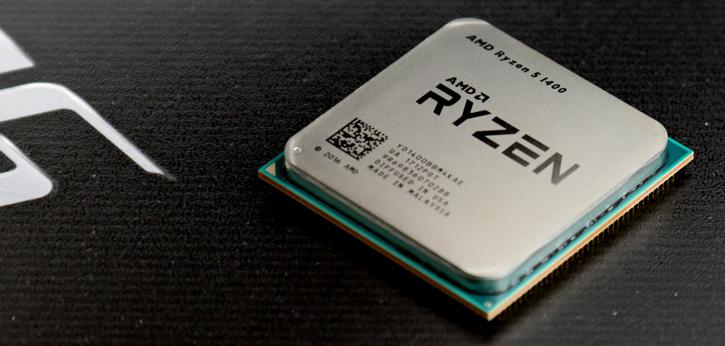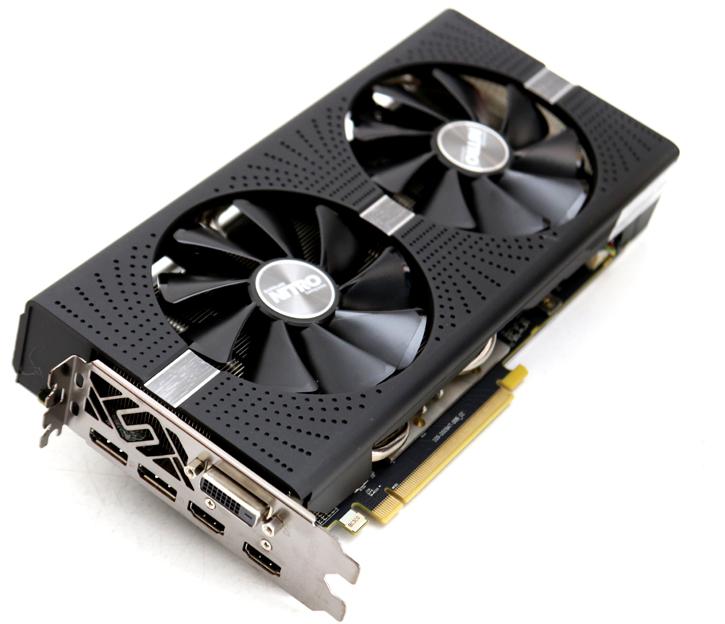The Nibble - The Mainstream Build
The Nibble- Our 'Everyone' Build
Likely the reason you're here now is that you want to try out a richer, more potential-filled side of PC gaming. Whilst 'The Bit' is a great entry level system, 'The Nibble' will use the extra budget almost solely for a more powerful graphics card, with the intent of providing near flawless 1080p, 60 FPS, very high/ultra IQ gameplay.
CPU - AMD Ryzen 5 1400
This time, my recommendation is singular, but for good reason. Whilst at the budget end of things, both Intel and AMD provided compelling options in the R3 1200 and G4560, at the 'mid' end of affairs, the competition - for me - is notably more clear cut. Yes, Intel's Coffee Lake platform is here, but what stopped me from recommending it for the lower end of things (i.e. the quad-core i3 8100) also stops me from recommending it here. Again, these are:
- A lack of 'budget' chipsets. Whilst this will likely change next year, right now (in December 2017), the only available Coffee Lake chipset is Z370, a higher end platform designed for overclocking CPUs.
- A short-lived lifespan. Whilst potentially a controversial opinion, Intel's Kaby Lake architecture lasted less than a year before being entirely superseded in performance and core count by Coffee Lake.
- An issue of 'price vs. performance.' Whereas a high-end gaming build only deserves a CPU like the 8700k, budget at this end of the scale should be put toward the GPU. Nothing else. There is no 'extra' money to throw around, so each penny counts. Ryzen provides exceptional price vs. performance, and that is why we have chosen it.
With that said, the AMD R5 1400 is my choice for this PC, hands down. You can check out our extensive review of this CPU here. We felt that it provided exceptional value for money, and potential buyers concerned about memory compatibility will be assured that numerous BIOS and AGESA updates since the review date have made memory compatibility and attainable 3000-3200Mhz speeds relatively easy to obtain!
Finally, a word on CPU cooling. The stock cooler (the 'Wraith Spire') is more than adequate for a modern 'all-core' 3.8Ghz overclock with the 1400. The exception to this would be if you truly want to hit that 4Ghz figure, or you live in a climate where ambient temperatures are naturally higher. There, a cheap aftermarket air cooler would be a good idea. The same advice operates here as it did for the budget APUs. Stick to air cooling, and keep the price below 35(ish) EUR.
Nvidia GTX 1060
At this price point, there is - right now - only one realistic option, as far as I can see. Nvidia's GTX 1060 provides compelling performance somewhere between last generation's GTX 970/980 at around 1/2 the price. Truly a remarkable achievement. We have reviewed numerous 1060's at Guru3D, and you can look at the extensive list here. A word of caution, please do not be tempted to overspend on a 'flashy' variant of the 1060. We are still aiming for value here, and higher end GPUs are very rarely worth it unless you are going for a particular aesthetic.
Depending on how much you wish to spend, Nvidia's 'baby' 1060 3GB is still the primary option, and still a compelling one. It is, ultimately, a slightly cut down version of the full-fat 6GB card, which results in slightly lower performance irrespective of the 3GB VRAM limit. The 3GB is 'enough' for 1080p gaming, but it may struggle at higher resolutions, and even at 1080p, some modern titles use a lot of VRAM, meaning you will have to turn down in game texture quality. For the most part though, it is a very solid card. If you can, naturally, find a good deal on the fully enabled 6GB 1060, then go for that.
Sapphire Radeon RX 570 with 4GB GDDR5 memory
The alternative to Nvidia's cards are AMD's Polaris based RX 570 (or RX 580). Whilst they are truly compelling at competitive options, both pricing and availability of these GPUs are horrifically affected by cryptocurrency mining. Should you wish to check out AMD' GPU offerings, the review of Sapphire's RX 570 4GB is here. Our review of the 580 is linked here, this time from the folks over at MSI. Both cards have options of either 4GB or 8GB onboard video memory. This will affect their resale value, but - in terms of viability 'now' - I would advise an 8GB RX 580, and a 4GB RX 570.
Motherboard - MSI B350 PC Mate
We will stick to the B350 chipset for this build, though a slightly higher-end version. When paying more for a motherboard, expect more features, rear port connectivity, and a stronger VRM. Without wishing to get technical, a VRM (standing for 'Voltage Regulator Modules') is a catchall term used to refer to the power delivery array to the CPU, i.e. the range of components responsible for turning the 12V from your PSU into usable power for your CPU. I chose the above board due to solid price, online reception, and seemingly wide acceptance by those moving to AMD's new platform (or, indeed, those building their first system). If, for some reason, you cannot find this board, then simply look for any B350 motherboard in the 85-100 Euro price point, and it will serve you well. At this value point, there is absolutely no need to step up to AMD's X370 chipset. That, readers, is solely the domain of the 'big boss' R7 chips. Feel free, also, to go for any other B350 board that takes your fancy. Read reviews, look at feedback. Etc.
System Memory - 8GB DDR4 @ 3000-3200Mhz
Simple fact. AMD Ryzen loves fast memory. In fact, faster memory - in crude terms - makes the CPU go faster, due to the way AMD's Ryzen chips are made. To that end, faster memory is always better, and this is the reason I have recommended memory with speeds of at least 3000Mhz. Finding said memory, luckily, is relatively simple (if, sadly, not cheap). 'But Mr. Writer!, you have not recommended anything specific! How am I to know what to buy?' That is a very good question, but one that - again, luckily - has a very simple answer. Any 8GB kit of DDR4 memory (2x 4GB sticks, please) from any reputable manufacturer will serve you well. Corsair, Kingston, AData, GSkill, Crucial, Team Group, etc. Do not worry about the brand here. That worrying will be saved for the higher end builds!
Storage - 1TB 7200rpm HDD + 120-250GB SSD
Ok, I lied. I'll admit it. Only 'some' of that extra money would be used for the GPU. The rest is ensuring you are truly in 2018 by having a PC that contains both an SSD (for boot) and HDD (for 'bulk' storage). Much of what I said in 'The Bit' build applies here. Your choices for HDD's lie mostly with Seagate or Western Digital. Your choices for a 120-250GB SSD remain the same. Stick to known brands, and use the link in 'The Bit' to go directly to our extensive SSD review list. You will likely see SSD's that are labeled as 'M.2' drives. This can be confusing, as most of us are likely used to more traditional 2.5'' drives. Many a modern mid-range motherboard can actually fit 1-2 M.2 drives. These drives are compelling as (if they use the NVMe interface) they are faster, but generally leave less cable clutter, and look 'cleaner.' However, they are more expensive, sometimes notably so. For now, stick to traditional 2.5'' drives. Should you wish to do your own research into the advantages of M.2 and what to buy, then first make sure your chosen board has M.2 slots! If it does, carry on.
Power Supply (PSU) - 500-550W, 80+ Bronze
Eagle-eyed readers will notice that the above title is (almost) copied from 'The Bit.' Why? Well, modern GPUs are so power efficient that even a high-end card such as a 1080Ti (yes, not a typo, even the 1080Ti) would run quite happily on a good quality 500W PSU (though it might be cutting things a little close), even if paired with something like an overclocked AMD R7 or high-end Coffee Lake CPU! Whilst - in my opinion - there is little point going for a PSU below 450W, the headroom afforded to you by a 500-550W unit gives you the potential to upgrade without having to worry about power draw. That said, my recommendations from before still stand. Linked here is our PSU review list, for those wanting to get an idea of what else is out there. For this PC, however, I would stick to the above recommendations, only breaking away from them if you absolutely know you will need more than 550W at some point (for whatever reason).
Odds and Ends
Much the same of what I said regarding 'The Bit' applies here. Do not cheap out on a case. Get a sound card if you need one (again, you need a sound card if you are the type of person to know you need one! Linked here is our list of speaker/soundcard reviews, if you are curious as to what is on offer, or simply what they do! Finally, a word on case choice. As the components we are using are starting to draw a little more power (and, naturally, power -> heat, by the laws of physics), a case that isn't entirely closed off or starved of airflow is a good idea! To that end, you do not, here, need to worry that much. Most modern ATX mid-tower cases have decent ventilation. If you are curious, you can check out our list of chassis reviews here, where airflow is always mentioned.
... but, you want something even more potent? Well, I guess we need to step it up a gear.



